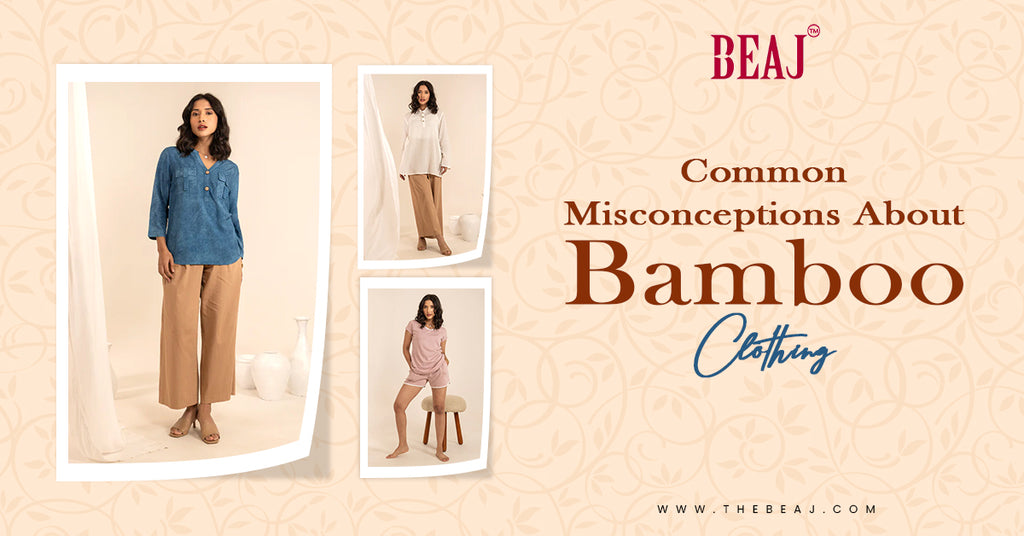Common Misconceptions About Bamboo Clothing
Posted by INDERPREET SINGH

Bamboo clothing has garnered significant attention in recent years for its eco-friendly properties and luxurious feel. With sustainability becoming a focal point in fashion, many individuals are turning to bamboo garments as an alternative to traditional fabrics. However, despite its growing popularity, there are still several misconceptions surrounding bamboo clothing that deserve clarification.
Let's explore these misconceptions and separate fact from fiction.
Misconception 1: Bamboo Clothing is Rough and ScratchyOne of the most prevalent misconceptions about bamboo clothing is that it has a rough and scratchy texture. However, this couldn't be further from the truth. When processed correctly, bamboo fabric is incredibly soft and smooth, often compared to the feel of silk or cashmere. The misconception likely stems from early iterations of bamboo fabric that were not processed efficiently. Today, advancements in textile technology have enabled manufacturers to produce bamboo clothing that is exceptionally soft and comfortable to wear.
Misconception 2: Bamboo Clothing is Only Available in Limited Styles
Another common misconception is that bamboo clothing is limited in style and design. Some people believe that bamboo garments are primarily basic and straightforward. However, the reality is quite the opposite. Bamboo fabric can be transformed into clothing, from casual t-shirts and leggings to elegant dresses and formal attire. Its versatility makes it suitable for multiple occasions, whether a relaxed weekend brunch or a corporate event.
Misconception 3: Bamboo Clothing is Not Durable
There is a misconception that bamboo clothing lacks durability compared to traditional fabrics like cotton or polyester. While it's true that bamboo fibres are naturally softer and more delicate than some other materials, they can still be durable when appropriately woven. Bamboo fabric is known for its strength and resilience, making it a viable option for everyday wear. Additionally, bamboo clothing retains its shape and colour well over time, offering longevity that rivals conventional fabrics.
Misconception 4: Bamboo Clothing is Expensive
Another misconception surrounding bamboo clothing is that it has a hefty price tag. While it's true that some bamboo garments may be priced higher than their conventional counterparts, this is not always the case. The cost of bamboo clothing can vary depending on manufacturing processes, brand reputation, and quality standards. However, with increased demand and improved production techniques, bamboo clothing has become more accessible and competitively priced in recent years. Furthermore, when considering the environmental benefits and durability of bamboo clothing, many consumers find it a worthwhile investment in the long run.
Misconception 5: Bamboo Clothing is Harmful to the Environment
Contrary to popular belief, bamboo clothing is not inherently environmentally harmful. Bamboo is considered one of the most sustainable materials in the world. Bamboo is a fast-growing grass that requires minimal water, pesticides, and fertilizers to thrive. It also has natural antibacterial properties, reducing the need for harsh chemicals during manufacturing. Additionally, bamboo forests play a crucial role in carbon sequestration, helping mitigate climate change. Consumers can support environmentally friendly practices and reduce their carbon footprint by choosing bamboo clothing.
Conclusion:
Bamboo clothing offers many benefits, from its luxurious feel to its eco-friendly attributes. By dispelling these common misconceptions, we can appreciate bamboo clothing for what it truly is: a versatile, durable, and sustainable option for the modern wardrobe. Whether lounging at home or attending a special event, consider incorporating bamboo garments into your attire. And if you're in search of the perfect bamboo cotton dress, look no further than "The Beaj" for stylish and sustainable options that will elevate your wardrobe while supporting ethical fashion practices.

